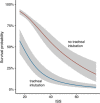Prehospital and emergency department airway management of severe penetrating trauma in Sweden during the past decade
- PMID: 38001526
- PMCID: PMC10675952
- DOI: 10.1186/s13049-023-01151-4
Prehospital and emergency department airway management of severe penetrating trauma in Sweden during the past decade
Abstract
Background: Prehospital tracheal intubation (TI) is associated with increased mortality in patients with penetrating trauma, and the utility of prehospital advanced airway management is debated. The increased incidence of deadly violence in Sweden warrants a comprehensive evaluation of current airway management for patients with penetrating trauma in the Swedish prehospital environment and on arrival in the emergency department (ED).
Methods: This was an observational, multicenter study of all patients with penetrating trauma and injury severity scores (ISSs) ≥ 15 included in the Swedish national trauma register (SweTrau) between 2011 and 2019. We investigated the frequency and characteristics of prehospital and ED TI, including 30-day mortality and patient characteristics associated with TI.
Result: Of 816 included patients, 118 (14.5%) were intubated prehospitally, and 248 (30.4%) were intubated in the ED. Patients who were intubated prehospitally had a higher ISS, 33 (interquartile range [IQR] 25, 75), than those intubated in the ED, 25 (IQR 18, 34). Prehospital TI was associated with a higher associated mortality, OR 4.26 (CI 2.57, 7.27, p < 0.001) than TI in the ED, even when adjusted for ISS (OR 2.88 [CI 1.64, 5.14, p < 0.001]). Hemodynamic collapse (≤ 40 mmHg) and low GCS score (≤ 8) were the characteristics most associated with prehospital TI. Traumatic cardiac arrests (TCAs) occurred in 154 (18.9%) patients, of whom 77 (50%) were intubated prehospitally and 56 (36.4%) were intubated in the ED. A subgroup analysis excluding TCA showed that patients with prehospital TI did not have a higher mortality rate than those with ED TI, OR 2.07 (CI 0.93, 4.51, p = 0.068), with OR 1.39 (0.56, 3.26, p = 0.5) when adjusted for ISS.
Conclusion: Prehospital TI was associated with a higher mortality rate than those with ED TI, which was specifically related to TCA; intubation did not affect mortality in patients without cardiac arrest. Mortality was high when airway management was needed, regardless of cardiac arrest, thereby emphasizing the challenges posed when anesthesia is needed. Several interventions, including whole blood transfusions, the implementation of second-tier EMS units and measures to shorten scene times, have been initiated in Sweden to counteract these challenges.
Keywords: Airway management; Intubation; Penetrating trauma; Prehospital; Trauma.
© 2023. The Author(s).
Conflict of interest statement
The authors declare that they have no competing interests.
Figures





Similar articles
-
Prehospital transportation of severe penetrating trauma victims in Sweden during the past decade: a police business?Scand J Trauma Resusc Emerg Med. 2023 Sep 8;31(1):45. doi: 10.1186/s13049-023-01112-x. Scand J Trauma Resusc Emerg Med. 2023. PMID: 37684674 Free PMC article.
-
Should trauma patients with a Glasgow Coma Scale score of 3 be intubated prior to hospital arrival?Prehosp Disaster Med. 2010 Nov-Dec;25(6):541-6. doi: 10.1017/s1049023x00008736. Prehosp Disaster Med. 2010. PMID: 21181689
-
Prehospital treatment of severely burned patients: a retrospective analysis of patients admitted to the Berlin burn centre.Scand J Trauma Resusc Emerg Med. 2024 Aug 14;32(1):70. doi: 10.1186/s13049-024-01239-5. Scand J Trauma Resusc Emerg Med. 2024. PMID: 39143646 Free PMC article.
-
[Emergency anesthesia, airway management and ventilation in major trauma. Background and key messages of the interdisciplinary S3 guidelines for major trauma patients].Anaesthesist. 2011 Nov;60(11):1027-40. doi: 10.1007/s00101-011-1957-1. Anaesthesist. 2011. PMID: 22089890 Review. German.
-
Airway management in penetrating neck trauma at a Canadian tertiary trauma centre.CJEM. 2007 Mar;9(2):101-4. doi: 10.1017/s148180350001486x. CJEM. 2007. PMID: 17391580 Review.
Cited by
-
Influence of on-scene time and prehospital interventions on inhospital mortality in trauma patients.BMC Emerg Med. 2025 Aug 20;25(1):163. doi: 10.1186/s12873-025-01324-7. BMC Emerg Med. 2025. PMID: 40830842 Free PMC article.
-
Endotracheal Intubation Outside the Operating Room: Year in Review 2023.Respir Care. 2024 Aug 24;69(9):1165-1181. doi: 10.4187/respcare.12014. Respir Care. 2024. PMID: 38744479 Review.
References
-
- The Swedish National Council for Crime Prevention. Murder and Manslaughter. (2021). Available online at: https://bra.se/bra-in-english/home/publications/archive/publications/202....
Publication types
MeSH terms
LinkOut - more resources
Full Text Sources
Medical
Miscellaneous

